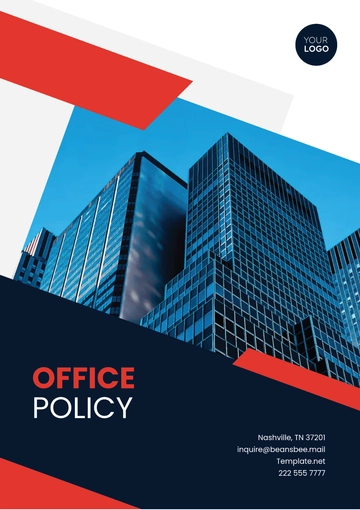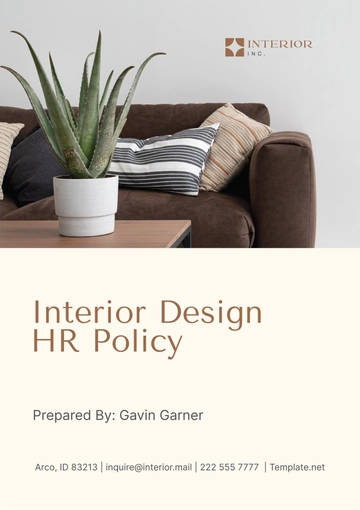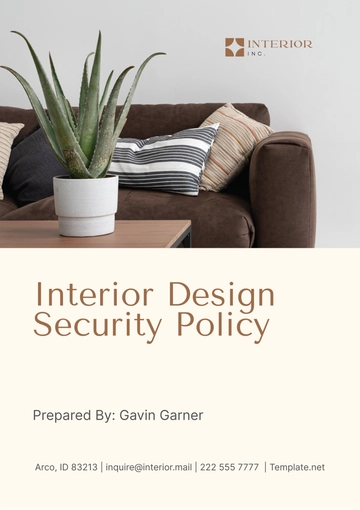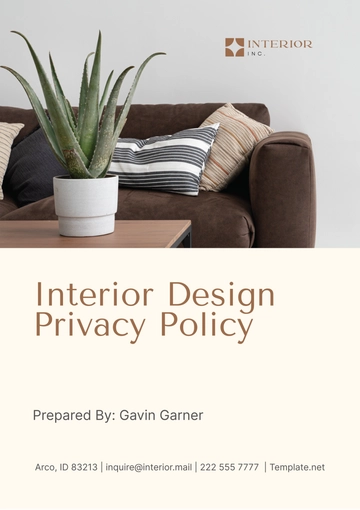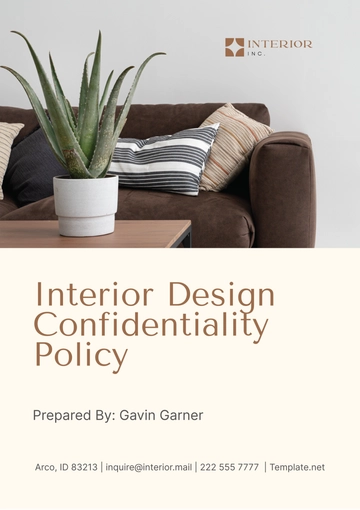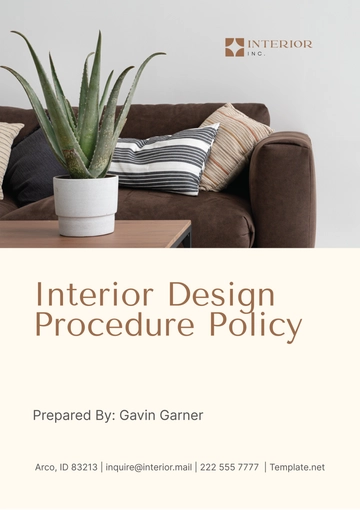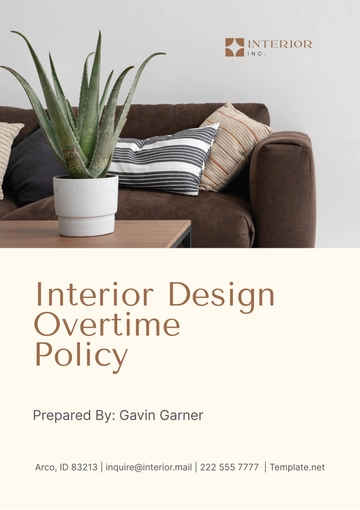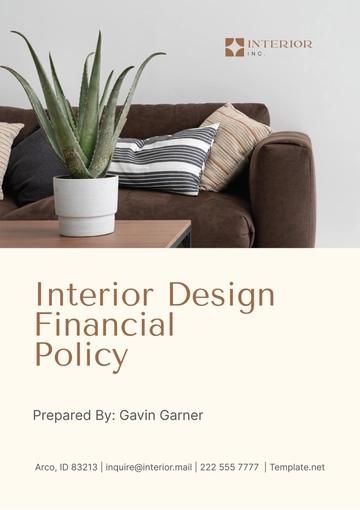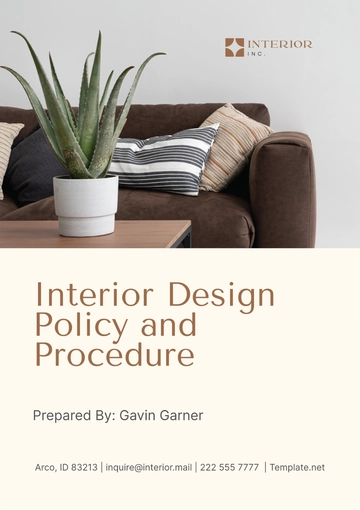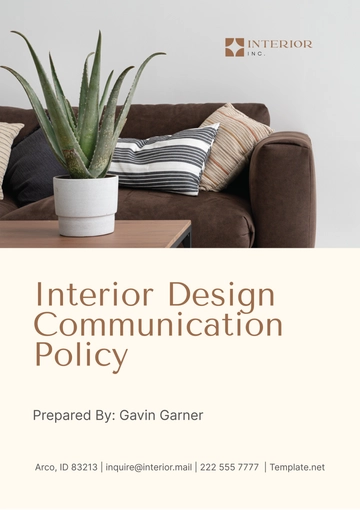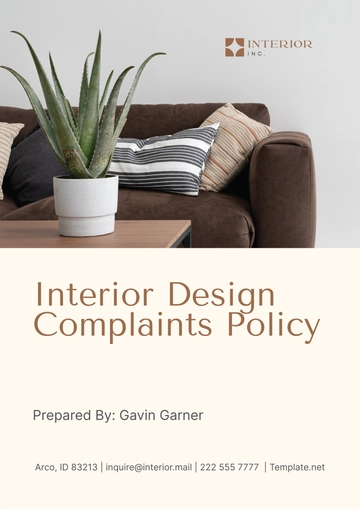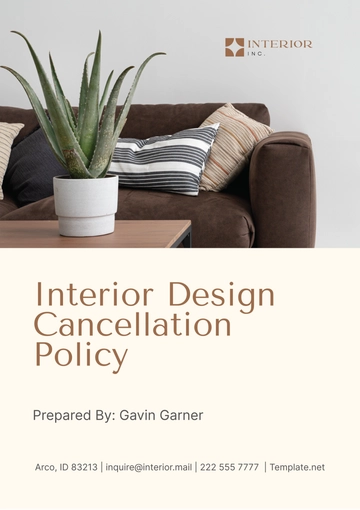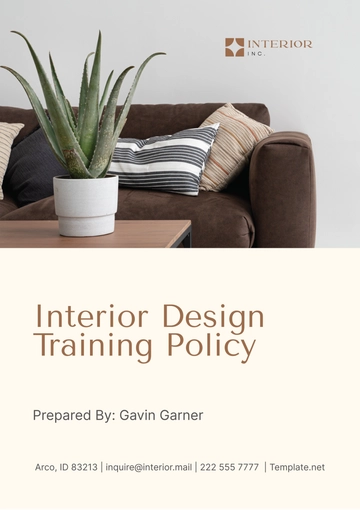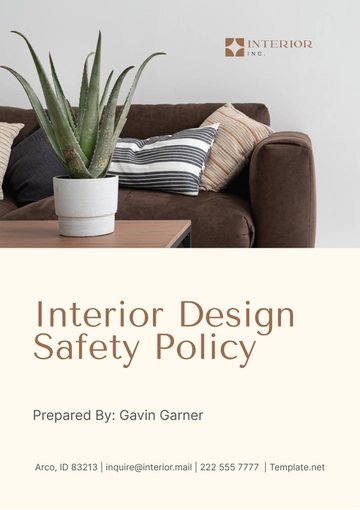Free Interior Design Complaints Policy
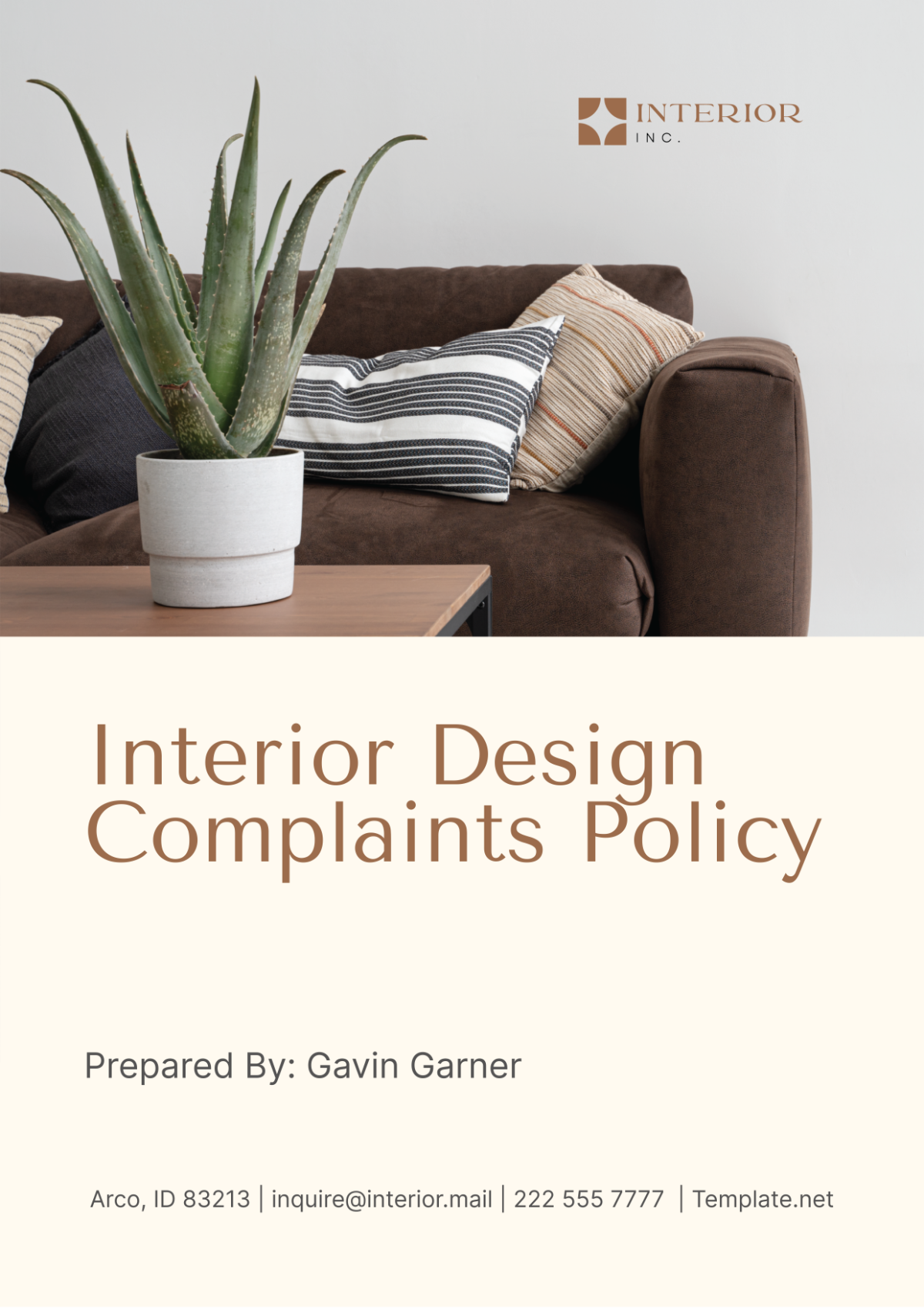
I. Purpose and Scope
The Complaints Policy of [Your Company Name] is established to ensure that every complaint received from clients, stakeholders, or employees is addressed promptly, fairly, and effectively. This policy encompasses all aspects of interaction with [Your Company Name], including interior design services, consultations, and project management.
II. Definitions
Complaint: Any expression of dissatisfaction, whether justified or not, regarding [Your Company Name]'s products, services, staff, or handling of a complaint, by a client or other stakeholders. Complaints may arise from various aspects of our operations, including but not limited to design concepts, project timelines, communication, or quality of workmanship.
Client: Refers to any individual or entity that has engaged [Your Company Name] for interior design services or related activities. Clients may include homeowners, businesses, property developers, architects, or any entity seeking our expertise in enhancing interior spaces.
Stakeholders: Encompasses individuals or entities with a vested interest in [Your Company Name]'s operations and outcomes. Stakeholders may include clients, employees, suppliers, partners, regulatory bodies, and the broader community impacted by our activities. Recognizing the diverse interests involved allows us to address complaints comprehensively and consider the broader implications on stakeholders.
III. How to Make a Complaint
Clients and stakeholders can file a complaint through multiple channels:
Direct Contact: Reach out to the designated project manager.
Email: Send a complaint to [Your Company Email].
Online Form: Utilize the complaint submission form available on our website.
IV. Complaint Handling Process
At [Your Company Name], we are committed to a structured and comprehensive approach to handling complaints. Our process ensures transparency, fairness, and efficiency in addressing issues raised by clients and stakeholders.
Receipt of Complaint: Upon receipt of a complaint, we prioritize acknowledgment to demonstrate responsiveness and respect for the concerns raised. Within 24 hours of receiving a complaint, [Your Company Name] will promptly acknowledge its receipt, providing reassurance to the complainant that their feedback is valued and being taken seriously.
Investigation: Each complaint is assigned to a designated complaints handler who possesses the necessary expertise and authority to conduct a thorough investigation. This investigation involves gathering relevant information, reviewing documentation, and engaging with relevant stakeholders to understand the nature and circumstances of the complaint fully.
Resolution: With a commitment to prompt resolution, [Your Company Name] endeavors to address complaints effectively and to the satisfaction of the complainant. Depending on the complexity and severity of the complaint, resolution strategies may include corrective actions, compensatory measures, or procedural improvements. We prioritize finding solutions that not only resolve the immediate issue but also prevent recurrence and enhance overall client satisfaction.
Communication: Transparent and timely communication is paramount throughout the complaints handling process. [Your Company Name] provides regular updates to the complainant, informing them of the progress made, any findings or decisions reached, and the anticipated timeline for resolution. Open dialogue ensures that expectations are managed, concerns are addressed promptly, and trust is maintained throughout the process.
Closure: Once the complaint has been resolved to the satisfaction of the complainant, [Your Company Name] considers the matter closed. Closure signifies the successful resolution of the issue and allows both parties to move forward positively. We remain accessible to address any follow-up questions or concerns that may arise post-resolution, reaffirming our commitment to customer satisfaction and ongoing support.
V. Timeframes
These timeframes are indicative of our commitment to prompt and efficient complaint resolution. While we strive to adhere to these timelines, we also recognize that certain complaints may require additional time for thorough investigation and resolution. Rest assured, we prioritize transparency and communication throughout the process to keep all parties informed of progress and expected timelines.
Aspect | Timeframe |
|---|---|
Acknowledgment | Within 24 hours of receiving the complaint |
Resolution | Aim to resolve within 10 working days |
VI. Confidentiality
Confidentiality is paramount in our handling of complaints at [Your Company Name]. We are committed to safeguarding the privacy and sensitive information of complainants throughout the process. Here's how we ensure confidentiality:
Limited Access: Access to complaint details and related information is restricted to individuals directly involved in the complaints handling process. This includes designated complaints handlers, relevant supervisors, and any other personnel necessitated by the investigation or resolution of the complaint.
Legal Compliance: While we prioritize confidentiality, we recognize that there may be circumstances where disclosure is required by law or regulatory authorities. In such cases, we ensure that any disclosures are made in accordance with applicable legal requirements and with due consideration for the privacy rights of the complainant.
Non-Disclosure: [Your Company Name] ensures that complainants' identities and the details of their complaints are not disclosed to unauthorized parties without explicit consent, except as required by law or in the context of the complaints handling process.
Data Security: We employ robust data security measures to protect complaint records and related information from unauthorized access, alteration, or disclosure. Our systems and processes adhere to industry best practices for data protection and privacy.
VII. Escalation Procedures
Our escalation procedures ensure that unresolved issues receive appropriate attention and are addressed promptly. Here's how we manage escalation:
Internal Review: If a complainant remains dissatisfied with the initial response to their complaint, they have the option to escalate the matter internally. The complaint will be reviewed by a higher-level authority, such as a senior manager, supervisor, or designated escalation officer, who will conduct a thorough assessment of the complaint and the actions taken thus far.
Escalation Contact: [Your Company Name] provides clear channels for escalation, including designated contact points or escalation officers responsible for overseeing escalated complaints. Complainants can reach out to these contacts directly, either through email, phone, or in-person meetings, to initiate the escalation process.
Escalation Timeline: We aim to address escalated complaints promptly, acknowledging receipt within 24 hours and providing regular updates on the progress of the review and resolution efforts. While we strive to resolve escalated complaints within a reasonable timeframe, the complexity of certain issues may require additional time for thorough investigation and resolution.
Resolution and Feedback: Once the escalated complaint has been thoroughly reviewed and resolved, [Your Company Name] communicates the outcome to the complainant, ensuring transparency and clarity regarding the actions taken. We also welcome feedback from complainants on their experience with the escalation process, using this input to improve our procedures and prevent similar issues in the future.
External Options: If a complainant remains unsatisfied with the outcome of the internal escalation process, they may have the option to pursue external avenues for resolution, such as regulatory authorities, industry ombudsmen, or legal recourse. [Your Company Name] provides guidance and support to complainants seeking external resolution, ensuring they are aware of their rights and available options.
VIII. Record Keeping
Effective record-keeping is essential for [Your Company Name] to track, analyze, and respond to complaints efficiently. We maintain accurate and comprehensive records of all complaints received and the actions taken to address them. Here's how we manage record-keeping:
Documentation: Every complaint received by [Your Company Name] is documented in detail, including the nature of the complaint, relevant dates, individuals involved, and any supporting documentation or evidence provided by the complainant.
Centralized Database: We utilize a centralized database or electronic system to store and manage complaint records securely. This ensures easy access to information for authorized personnel involved in the complaints handling process.
Retention Period: Complaint records are retained for a specified period in accordance with applicable laws, regulations, and internal policies. The retention period may vary depending on the nature of the complaint and any legal requirements governing the retention of records.
IX. Compliance
[Your Company Name] is committed to adhering to all relevant laws, regulations, and industry standards in handling complaints, ensuring transparency, fairness, and accountability throughout the process.
Consumer Protection Laws: Compliance with consumer protection laws ensures that [Your Company Name] handles complaints in a manner that respects the rights of consumers, including provisions related to fair treatment, transparency, and dispute resolution.
Data Protection Regulations: Adherence to data protection regulations, such as the General Data Protection Regulation (GDPR) in the European Union or the California Consumer Privacy Act (CCPA) in the United States, ensures the secure handling and processing of personal data collected during the complaints handling process.
Industry Codes of Practice: Compliance with industry-specific codes of practice, guidelines, or standards ensures that [Your Company Name] meets industry best practices and standards for complaints handling within the interior design sector.
Labor Regulations: Compliance with labor regulations ensures that [Your Company Name] maintains a fair and respectful workplace environment, including provisions related to employee rights, grievance procedures, and non-retaliation against whistleblowers.
Contractual Obligations: Compliance with contractual obligations ensures that [Your Company Name] fulfills its commitments to clients, suppliers, and other stakeholders regarding complaints handling processes and outcomes as specified in contractual agreements.
X. Contact Information
For any inquiries or clarifications regarding this Complaints Policy, please contact:
[Contact Person]
[Department]
[Contact Person Number]
[Contact Person Email]
- 100% Customizable, free editor
- Access 1 Million+ Templates, photo’s & graphics
- Download or share as a template
- Click and replace photos, graphics, text, backgrounds
- Resize, crop, AI write & more
- Access advanced editor
Foster client satisfaction and professionalism in your interior design business with Template.net's Interior Design Complaints Policy Template. Editable in our AI Editor Tool, this customizable document provides a structured framework for handling client complaints effectively and transparently. Crafted to address grievances promptly and maintain positive client relationships, it ensures a seamless experience.
You may also like
- HR Policy
- Restaurant Policy
- Company Policy
- Accounting Policies and Procedures
- Website Policy
- Privacy Policy
- Safety Policy
- School Policy
- IT and Software Policy
- Law Firm Policy
- Construction Policy
- Interior Design Policy
- Travel Agency Policy
- Education Academic Policy
- Security Policy
- Real Estate Policy
- Expense Policy
- Software Policy
